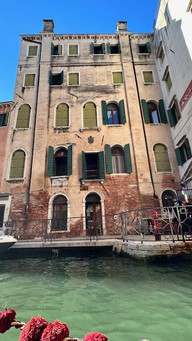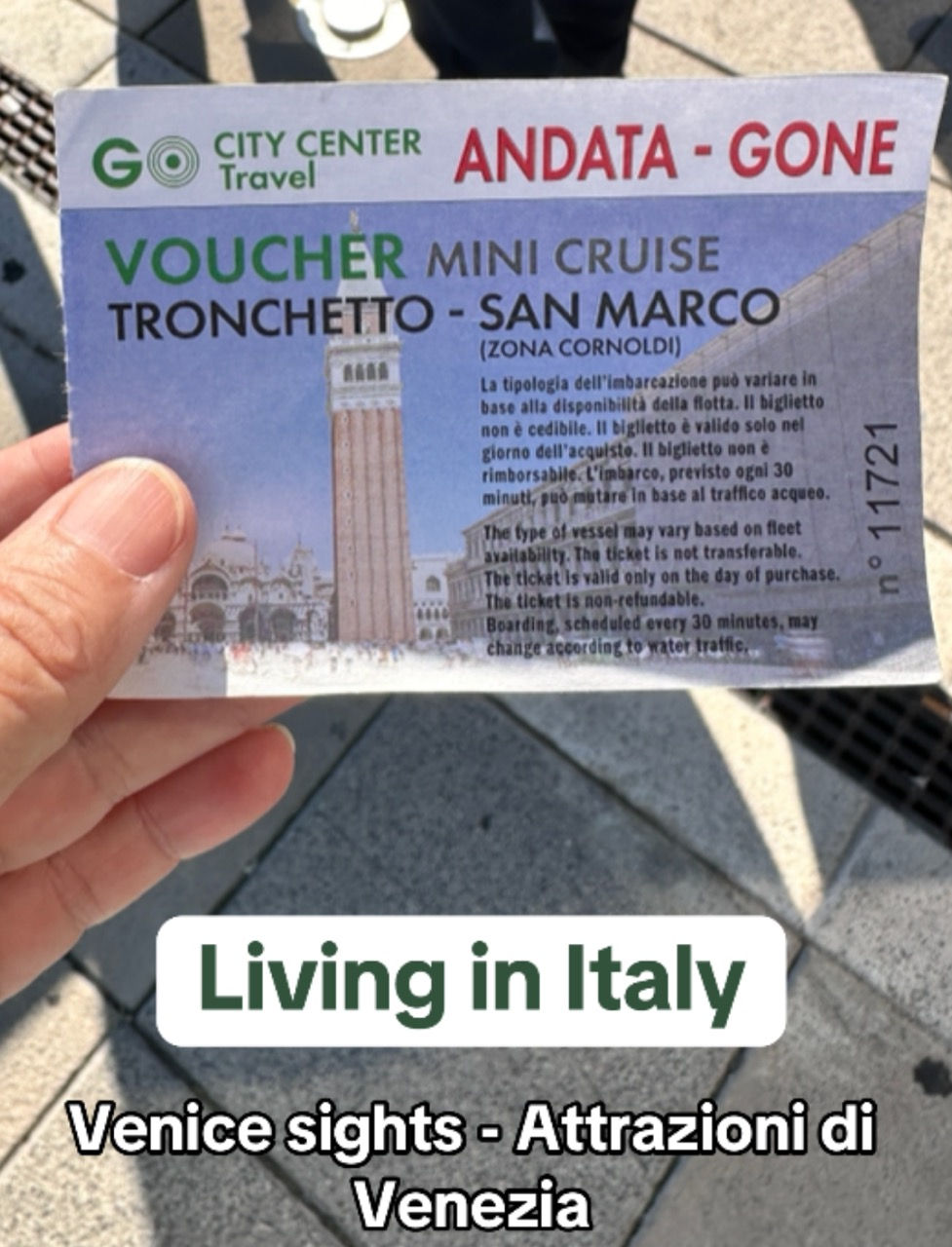Venice Grand Canal – Canal Grande Venezia
- Maria Scuor
- Oct 20, 2024
- 9 min read
Italiano sotto ogni sezione
Here is a TikTok video of the Grand Canal and Rialto Bridge - Ecco un video TikTok del Canal Grande e del Ponte di Rialto
We spent an amazing 36 hours in Venice with our friends Glenn and Kirsten and there will be a few blogs researching and capturing the essence of Venice. Truly a magical place.
In this blog we are learning about the Venice’s Grand Canal and the Rialto Bridge that spans across it. The Grand Canal is the main canal that crosses the historic centre of Venice. It is about 3800 meters (2 miles) long, 30 – 70 m (100 – 225 ft) wide and 5 m (15 ft) deep at its deepest. It’s “Ƨ” shape divides the centre into two parts from San Marco Basilica to Santa Chiara Church.
This canal connects at various points with a maze of 150 smaller canals and these waterways carry the bulk of Venetian transportation as automobiles are banned throughout the city. As you walk down the canal you will see palaces, churches, hotels and many other buildings lining either side of the canal. Along the entire length of the canal are about 170 Romanesque, Gothic and Renaissance styles buildings that date from the 12th to 18th centuries and give the canal much beauty. Most of these were built by wealthy Venetian families.
There are four bridges that cross the Grand Canal with the oldest and most famous the Rialto with the others being Ponte degli Scalzi, Ponte dell' Accademia and Ponte di Costituzione. It is believed the Grand Canal follows an ancient river with the first settlements being around the current Rialto bridge.
By the 10th century, it became a center for trade because of its safe ship-accessible port. Some of the earliest houses belonged to merchants who did their business on the seas.
Here is the evolutions of the houses on the canal
Houses became more ornate by the 12th and 13th centuries with Byzantine-style decoration and elongated arches and large loggias
The Gothic styles appeared in the 15th century, with its facades in bright colours, pointed arches and skinnier columns
The Renaissance and Classical styles of the 16th century featured the white facades, round windows and arches that were round instead of pointed
The Baroque styles of the late 16th and early 17th centuries brought grandeur, drama and contrast in lightening, with rich surfaces with twisting elements and gilded statuary
By the 18th century, building along the Grand Canal had pretty much stopped. However in the last two centuries there has been significant renovations completed and the most important ones have become museums or are owned by foundations that see to their maintenance.
The first Sunday of September you can watch the historical Regatta, which is a Venetian rowing sporting event related to a historical reenactment. It is not known exactly when the regattas began but scholars believe it could date back to 942 when during a popular festival, pirates kidnaped Venetian women but were immediately chased by men who, rowing furiously managed to reach and free the young women. From this the Festa delle Marie is associated with the regatta origins.
The first date the term “regatta” appears dates back to 1274 and therefore then regattas between large boats were taking place. In 1315 the Senate decreed the annual Festa della Marie Regatta. But it wasn’t until later that these became impressive and grandiose. Today there is a historical procession that takes place along the Grand Canal, followed by competitive regattas.
Since the 1950s, competition has been held exclusively with the following types of boats:
Mascarete: 8 meters long, heavy 220 kg, with double oar rowing, used by women
Pupparini: 9 meters long, heavy 380 kg, with double oar rowing, used by young people; in the past they were elegant casada boats
Caorline: 10 meters long, heavy 600 kg, with six-oared rowing; historically they were transport boats
Gondolini: 11 meters long, heavy 200 kg, with double oar rowing; streamlined and very technical, they are the only boats designed specifically for the regatta and very fast
The Venetian rowing races that take place during the Regata Storica are, in chronological order:
The senior maciarele regatta, for children up to 14 years old
The schie regatta, for children up to 10 years old
The junior maciarele regatta, for children up to 12 years old
The regatta for very young women on two-oared mascaretes (race started in 2024)
The regatta for the very young on two-oared pupparini
The six-oared caorline regatta; each caorlina represents a zone of Venice
The women's regatta on two-oared mascaretes
The champions' regatta on two-oared gondolas
Nine crews participate in each regatta with a reserve crew if in case of a cancellation. Each crew must wear white trousers/skirts and with the striped shirt typical of gondoliers and bands of the same color as their boat. A shot of a gun starts the race and racers require endurance as a race usually lasts 35 – 40 minutes. Because there are clashes between crews, the Municipality appointed a body of referees to supervise and ensure compliancy with the technical regulations during the races.
The first four crews in win cash prizes and the traditional and symbolic flags: red for the first classified, white for the second, green for the third and blue for the fourth. Up until 2002, the fourth-place winner would also win a live piglet but with protests of animal rights activists this has now been changed to a Murano glass piglet made specifically for this occasion. In 2021, the municipality equalized the prize money for male and female racers.
Here are photos of the Grand Canal - Ecco le foto del Canal Grande
Canal Grande Venezia
Abbiamo trascorso 36 ore fantastiche a Venezia con i nostri amici Glenn e Kirsten e ci saranno alcuni blog che ricercheranno e cattureranno l'essenza di Venezia. Davvero un posto magico.
In questo blog stiamo imparando del Canal Grande di Venezia e del Ponte di Rialto che lo attraversa. Il Canal Grande è il canale principale che attraversa il centro storico di Venezia. È lungo circa 3800 metri, largo 30-70 m e profondo 5 m nel punto più profondo. La sua forma a "Ƨ" divide il centro in due parti dalla Basilica di San Marco alla Chiesa di Santa Chiara.
Questo canale si collega in vari punti con un labirinto di 150 canali più piccoli e questi corsi d'acqua trasportano la maggior parte del trasporto veneziano poiché le automobili sono vietate in tutta la città. Mentre cammini lungo il canale vedrai palazzi, chiese, hotel e molti altri edifici che fiancheggiano entrambi i lati del canale. Lungo l'intera lunghezza del canale si trovano circa 170 edifici in stile romanico, gotico e rinascimentale che risalgono al XII e XVIII secolo e conferiscono al canale molta bellezza. La maggior parte di questi furono costruiti da ricche famiglie veneziane.
Sono quattro i ponti che attraversano il Canal Grande con il più antico e famoso Rialto con gli altri Ponte degli Scalzi, Ponte dell'Accademia e Ponte di Costituzione. Si ritiene che il Canal Grande segua un antico fiume e i primi insediamenti si trovino intorno all'attuale ponte di Rialto.
Nel X secolo, divenne un centro per il commercio grazie al suo porto sicuro e accessibile alle navi. Alcune delle prime case appartenevano a mercanti che facevano i loro affari sui mari. Ecco le evoluzioni delle case sul canale
Nel XII e XIII secolo, le case divennero più ornate con decorazioni in stile bizantino e archi allungati e grandi logge
Lo stile gotico apparve nel XV secolo, con le sue facciate dai colori vivaci, gli archi a sesto acuto e le colonne più sottili
Gli stili rinascimentale e classico del XVI secolo erano caratterizzati da facciate bianche, finestre a tutto sesto e archi rotondi anziché appuntiti
Gli stili barocchi della fine del XVI e dell'inizio del XVII secolo portarono grandezza, drammaticità e contrasto nell'alleggerimento, con ricche superfici con elementi tortuosi e statue dorate
Nel XVIII secolo, la costruzione lungo il Canal Grande si era praticamente fermata. Tuttavia, negli ultimi due secoli sono stati completati importanti lavori di ristrutturazione e i più importanti sono diventati musei o sono di proprietà di fondazioni che ne curano la manutenzione.
La prima domenica di settembre è possibile assistere alla Regata Storica, che è una manifestazione sportiva di voga alla veneta legata ad una rievocazione storica. Non si sa con esattezza quando iniziarono le regate ma gli studiosi ritengono che possa risalire al 942 quando, durante una festa popolare, i pirati rapirono delle donne veneziane ma furono subito inseguiti dagli uomini che, remando furiosamente, riuscirono a raggiungere e liberare le giovani donne. Da qui la Festa delle Marie si associa alle origini della regata.
La prima data in cui compare il termine "regata" risale al 1274 e quindi poi si svolgevano le regate tra grandi imbarcazioni. Nel 1315 il Senato decretò l'annuale Festa della Marie Regatta. Ma è stato solo più tardi che questi sono diventati impressionanti e grandiosi. Oggi si svolge un corteo storico che si svolge lungo il Canal Grande, seguito da regate competitive.
Dagli anni '50, la competizione si è svolta esclusivamente con i seguenti tipi di imbarcazioni:
Mascarete: 8 metri di lunghezza, peso 220 kg, con canottaggio a doppio remo, utilizzato dalle donne
Pupparini: lunghi 9 metri, pesanti 380 kg, con canottaggio a doppio remo, utilizzati dai giovani; In passato erano eleganti barche Casada
Caorline: 10 metri di lunghezza, pesa 600 kg, con remi a sei remi; Storicamente erano barche da trasporto
Gondolini: 11 metri di lunghezza, pesa 200 kg, con voga a doppio remo; Snelle e molto tecniche, sono le uniche barche progettate appositamente per la regata e molto veloci
Le gare di voga alla veneta che si svolgono durante la Regata Storica sono, in ordine cronologico:
La Regata Senior Maciarele, per bambini fino a 14 anni
La regata delle Schie, per bambini fino a 10 anni
La Regata Junior Maciarele, per bambini fino a 12 anni
la regata per giovanissime donne su mascarete a due remi (gara iniziata nel 2024)
La regata per i giovanissimi su pupparini a due remi
la Regata delle Caorline a sei remi; ogni caorlina rappresenta una zona di Venezia
La regata femminile su mascarete a due remi
La regata dei campioni su gondole a due remi
Nove equipaggi partecipano ad ogni regata con un equipaggio di riserva in caso di cancellazione. Ogni equipaggio dovrà indossare pantaloni/gonne bianche e con la camicia a righe tipica dei gondolieri e fasce dello stesso colore della propria imbarcazione. Un colpo di pistola dà il via alla gara e i corridori richiedono resistenza poiché una gara di solito dura 35-40 minuti. A causa degli scontri tra equipaggi, il Comune ha nominato un corpo di arbitri per vigilare e garantire il rispetto del regolamento tecnico durante le gare.
I primi quattro equipaggi si aggiudicheranno premi in denaro e le tradizionali e simboliche bandiere: rossa per il primo classificato, bianca per il secondo, verde per il terzo e blu per il quarto. Fino al 2002, il quarto classificato vinceva anche un maialino vivo, ma con le proteste degli attivisti per i diritti degli animali questo è stato ora cambiato in un maialino in vetro di Murano fatto appositamente per questa occasione. Nel 2021, il comune ha equiparato il premio in denaro per i corridori maschili e femminili.
Rialto Bridge – Ponte Rialto
The Rialto Bridge connects the sestieri (districts) of San Marco and San Polo and as mentioned before is the largest on the Grand Canal. It was first built as a pontoon (floating) bridge in 1173 and originally names the Ponte della Moneta, probably because of the mint that was at the eastern entrance. It has been rebuilt several times and is now a major tourist attraction in the city of Venice.
Because of the importance of the Rialto market, the floating bridge was replaced by a wooden bridge in 1255. The maintenance of the wooden bridge was vital but it partly burnt in 1310, then collapsed in 1444 when the weight of a crowd rushing to see the marriage of the Marquis of Ferrara and then collapsed again in 1524.
The present stone bridge construction started in 1588 and was completed in 1591. It is a single span bridge designed by Antonio da Ponte. Two ramps lead up to the central portico and on either side of the portico there are covered ramps that have shops on them. The bridge was considered so audacious that architect Vincenzo Scamozzi predicted it wouldn’t last. However, it has defied its critics to become one of the architectural icons and top tourist attractions in Venice.
It truly is an amazing bridge to look at and walking up it early in the morning allows you to see the incredible views in every direction without so many people on it.
Here are photos of the Rialto Bridge - Ecco le foto del Ponte Rialto
Ponte Rialto
Il Ponte di Rialto collega i sestieri di San Marco e San Polo e, come accennato in precedenza, è il più grande del Canal Grande. Fu costruito per la prima volta come ponte di barche (galleggiante) nel 1173 e originariamente prende il nome di Ponte della Moneta, probabilmente a causa della zecca che si trovava all'ingresso orientale. È stata ricostruita più volte ed è oggi una delle principali attrazioni turistiche della città di Venezia.
A causa dell'importanza del mercato di Rialto, il ponte galleggiante fu sostituito da un ponte di legno nel 1255. La manutenzione del ponte di legno fu vitale ma in parte bruciò nel 1310, poi crollò nel 1444 quando il peso di una folla accorreva per assistere alle nozze del marchese di Ferrara per poi crollare nuovamente nel 1524.
L'attuale costruzione del ponte in pietra iniziò nel 1588 e fu completata nel 1591. Si tratta di un ponte a campata unica progettato da Antonio da Ponte. Due rampe conducono al portico centrale e su entrambi i lati del portico ci sono rampe coperte che hanno negozi su di esse. Il ponte era considerato così audace che l'architetto Vincenzo Scamozzi predisse che non sarebbe durato. Tuttavia, ha sfidato i suoi critici per diventare una delle icone architettoniche e delle principali attrazioni turistiche di Venezia.
È davvero un ponte incredibile da guardare e salirci la mattina presto ti permette di vedere le viste incredibili in ogni direzione senza così tante persone su di esso.












































Comments